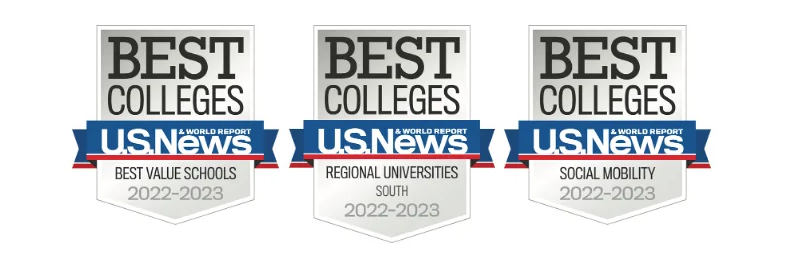
Event, News by admin Sep 08, 2023
U.S. News Calculated the 2022-2023 Best Colleges Rankings
How U.S. News Calculated the 2022-2023 Best Colleges Rankings
Here is a breakdown of what goes into the annual rankings.
U.S. News' directory of institutions contains each school's rankings data and key characteristics about majors, campus life, costs of attending, and more. Users can filter schools by selected academic and non-academic characteristics along their priorities.
Background on This Year's Rankings
Although the methodology is the product of years of research, US News continuously refine their approach based on user feedback, literature reviews, trends of data and availability of new data. US NEWS regularly engage with institutional researchers and high-ranking academic officials, including presenting at higher education forums and conducting interactive webinars.
U.S. News surveyed schools in the spring and summer of 2022. However, the ranking factors themselves are snapshots of the recent past, reflecting fall 2021 and earlier.
How Ranks Are Determined
US NEWS Calculates 10 distinct overall rankings where colleges and universities were grouped by their academic missions. For each ranking, the sum of weighted, normalized values across 17 indicators of academic quality determine each school's overall score and, by extension, its overall rank.
The top performer(s) in each ranking displays an overall score of 100. Others' overall scores are on a 0-99 scale reflecting the distance from their ranking's top-performing school(s). Those placing outside the top 75% display their ranking's bottom quartile range (e.g., No. 90-120) instead of their individual ranks (e.g., No. 102).
The Ranking Factors
|
RANKING FACTOR |
NATIONAL UNIVERSITIES AND NATIONAL LIBERAL ARTS COLLEGES INDICATOR WEIGHT |
REGIONAL UNIVERSITIES AND REGIONAL COLLEGES INDICATOR WEIGHT |
|---|---|---|
|
GRADUATION AND RETENTION RATES |
22% |
22% |
|
AVERAGE SIX-YEAR GRADUATION RATE |
17.6% |
17.6% |
|
AVERAGE FIRST-YEAR STUDENT RETENTION RATE |
4.4% |
4.4% |
|
SOCIAL MOBILITY |
5% |
5% |
|
PELL GRANT GRADUATION RATES |
2.5% |
2.5% |
|
PELL GRANT GRADUATION RATE PERFORMANCE |
2.5% |
2.5% |
|
GRADUATION RATE PERFORMANCE |
8% |
8% |
|
UNDERGRADUATE ACADEMIC REPUTATION |
20% |
20% |
|
PEER ASSESSMENT SURVEY |
20% |
20% |
|
FACULTY RESOURCES FOR 2021-2022 ACADEMIC YEAR |
20% |
20% |
|
CLASS SIZE INDEX |
8% |
8% |
|
FACULTY COMPENSATION |
7% |
7% |
|
PERCENT FULL-TIME AND PART-TIME FACULTY WITH TERMINAL DEGREE IN THEIR FIELD |
3% |
3% |
|
PERCENT FACULTY THAT IS FULL TIME |
1% |
1% |
|
STUDENT-FACULTY RATIO |
1% |
1% |
|
STUDENT SELECTIVITY FOR THE FALL 2021 ENTERING CLASS |
7% |
7% |
|
MATH AND EVIDENCE-BASED READING AND WRITING PORTIONS OF THE SAT AND THE COMPOSITE ACT SCORES |
5% |
5% |
|
HIGH SCHOOL CLASS STANDING IN TOP 10% |
2% |
0% |
|
HIGH SCHOOL CLASS STANDING IN TOP 25% |
0% |
2% |
|
FINANCIAL RESOURCES PER STUDENT |
10% |
10% |
|
AVERAGE ALUMNI GIVING RATE |
3% |
3% |
|
GRADUATE INDEBTEDNESS |
5% |
5% |
|
GRADUATE INDEBTEDNESS TOTAL |
3% |
3% |
|
GRADUATE INDEBTEDNESS PROPORTION WITH DEBT |
2% |
2% |
|
TOTAL |
100% |
100% |
Outcomes (40%)
Forty percent of a school's rank is comprised of seven different outcome measures related to schools' success at enrolling, retaining and graduating students from diverse backgrounds with manageable debt.
Graduation and Retention
- Graduation rates (17.6%) is a four-year rolling average of the proportion of each entering class (fall 2012-2015) earning a bachelor's degree in six years or less.
- First-year retention rates (4.4%) is a four-year rolling average of the proportions of first-year entering students (fall 2017-fall 2020) who returned the following fall.
Graduation rate performance (8%) compares each college's six-year graduation rates with what we predicted for their fall 2014 and fall 2015 entering classes, based on each school's characteristics. The more a school's actual graduation rate exceeded its predicted graduation rate, the more it exceeded expectations – and scored higher on this indicator. The predicted rates were modeled from its students' socioeconomic backgrounds – namely those awarded Pell Grants and who were first in their families to attend college, as well as admissions data, school financial resources, and National Universities' math and science orientations.
Social mobility measures how well schools graduated students who received federal Pell Grants – typically from households earning less than $50,000 annually. U.S. News published adistinct social mobility ranking for all ranked schools. The social mobility ranking was computed by aggregating the two ranking factors assessing graduation rates of Pell-awarded students.
- Pell graduation rates (2.5%) incorporate six-year bachelor's degree-seeking graduation rates of Pell Grant students from the fall 2015 and 2014 entering classes, adjusted to give much more credit to schools with larger Pell student proportions.
- Pell graduation performance (2.5%) compares each school's six-year bachelor's degree-seeking graduation rate among Pell recipients with its six-year graduation rates among non-Pell recipients, then adjusts to give significantly more credit to schools who enrolled larger Pell student proportions. The higher a school's Pell graduation rate relative to its non-Pell graduation rate up to the rates being equal, the better it scores. This, too, is computed as a two-year rolling average from the fall 2015 and fall 2014 entering classes.
Graduate indebtedness is a prime concern of students who must weigh the benefits of their college degree with the affordability of attending college itself. Both factors incorporated federal loans and co-signed loans to eventual graduates, and excluded students who transferred in, money borrowed at other institutions, parent loans and students who did not graduate with a bachelor's degree.
- Graduate indebtedness average (3%) assesses each school's average accumulated federal loan debt among its 2020 and 2021 bachelor's degree graduating classes of borrowers by comparing their amounts to those among ranked schools in their U.S. News ranking category.
- Graduate indebtedness proportion (2%) is the percentage of graduates from the 2020 and 2021 bachelor's degree graduating classes who borrowed federal loans. This ranking factor credits schools for meeting the full financial need without loans of their undergraduates (who would not be included in the graduate indebtedness total cohort) by comparing the proportions who borrowed to other schools in their U.S. News ranking category.
Faculty Resources (20%)
Research shows the greater access students have to quality instructors, the more engaged they will be in class and the more they will learn and be satisfied with their instructors. U.S. News uses five factors comprising 20% of a school's overall rank from the 2021-2022 academic year to assess a school's commitment to instruction.
- Class size (8%) has schools scoring better with greater proportions of smaller classes for fall 2021. The current methodology reverts to using only the most recent year of data, following last year's edition that introduced a two-year average to downweight the influence of fall 2020 data when distance learning was temporarily much more prevalent.
- Faculty salaries (7%) assesses the average salaries, excluding benefits, for full-time instructional professors, associate professors and assistant professors for 2021-2022, using definitions from the American Association of University Professors. Salary data was adjusted for regional differences in the cost of living using the U.S. Bureau of Economic Analysis regional price parities indexes, published in December 2021. Average salary values are computed only for the 2021-2022 academic year, and not as a two-year average like in the previous edition.
- Faculty with terminal degree (3%) is the proportion of full-time equivalent instructional faculty with doctorate or highest degree in their field or specialty during the 2021-2022 academic year. Assessing part-time faculty in addition to full-time faculty – in which part-time faculty were weighted as one-third of full-time faculty in equivalency – is a change from previous editions when only full-time faculty were assessed. This was done to be more comprehensive, because in recent years there has been a large increase in part-time faculty instructors.
- Student-faculty ratio (1%) is the ratio of undergraduate students to instructional faculty.
- Proportion of faculty who are full-time (1%) compares the counts of full-time faculty to part-time faculty who are teaching courses.
Expert Opinion (20%)
Academic reputation matters because it factors things that cannot easily be captured elsewhere. For example, an institution known for having innovative approaches to teaching may perform especially well on this indicator, whereas a school struggling to keep its accreditation will likely perform poorly.
Each year, top academics – presidents, provosts and deans of admissions – rate the academic quality of peer institutions with which they are familiar on a scale of 1 (marginal) to 5 (distinguished). We take a two-year weighted average of the ratings. The 2022-2023 Best Colleges rankings factor in scores from both 2022 and 2021.
The very small proportion of schools that received fewer than 10 cumulative ratings (exclusively regional institutions in the 2022-2023 edition) receive assigned values equaling the lowest average score among schools that received at least 10 ratings.
U.S. News collected the most recent data by administering peer assessment surveys to schools in spring and summer 2022. Of the 4,838 academics who were sent questionnaires on the overall rankings in 2022, 34.1% responded – unchanged from 2021. The peer assessment response rate for the National Universities category was 43.6% and the National Liberal Arts category was 49.7%.
Schools interested in a breakdown of their peer assessment ratings by respondent type and region can access this information, along with 29 million other data points, with a subscription to U.S. News' Academic Insights. This web-based platform facilitates a deep dive for studying and benchmarking the rankings and is designed for colleges and universities only.
Financial Resources (10%)
Generous per-student spending indicates a college can offer a variety of programs and services. U.S. News measures financial resources by using the average spending per student on instruction, research, student services and related educational expenditures in the 2020 and 2021 fiscal years. Expenditures were compared with fall 2019 and fall 2020 full-time and part-time undergraduate and graduate enrollment, respectively. The continued two-year average of scores hedges against instability toward schools' budgets that may have been introduced in the 2020 fiscal year by reaction to the coronavirus pandemic.
Student Excellence (7%)
Selective admissions enables talented, hard-working students to share a learning environment with their academic peers and enables instructors to design rigorous classes. Two indicators of student excellence comprised 7% of the ranking.
Standardized tests (5%): U.S. News factors average test scores for all enrollees who took the mathematics and evidence-based reading and writing portions of the SAT and the composite ACT. Both SATs and ACTs were converted to their 0-100 test-taker percentile distributions and weighted based on the proportions of new entrants submitting each exam. For example, if a school had two-thirds of its test-takers submitting ACT scores and one-third submitting SAT scores, its ACT scores would weigh twice as heavily as its SAT scores toward this ranking factor.
Many test centers closed in 2020 out of concern for public health, while supply and demand for taking the SAT and ACT plummeted, especially among applicants from low-income backgrounds. For fair comparisons, the following methodology changes were adopted this edition:
- By default, we assessed schools on their fall 2021 SAT/ACT scores if and only if they were reported on at least half their new entrants.
- For schools not meeting the first condition, we assessed them on their fall 2020 SAT/ACT scores (scaled to fall 2020 percentile distributions) if and only if they were reported on at least half their fall 2020 new entrants. These entering students' testing period predated the effects of the COVID-19 pandemic, resulting in the majority of institutions being included in the first two bullets.
- For schools reporting SAT/ACT on less than 50% of both their fall 2021 and fall 2020 entering classes – including test-blind schools – we did not assess them on standardized tests at all. Instead, for those schools we increased the weights of two other ranking factors that have historically correlated with standardized testing: high school class standing and average graduation rate.
For this edition, we also discontinued our prior practice of discounting schools for reporting SAT/ACT scores on too few new entrants. Schools were either assessed on their test scores or they were not. However, we continued our practice of discounting school's percentile scores by 15% if they failed to confirm that their reported scores included all students who submitted scores from these categories: athletes, international students, minority students, legacies, those admitted by special arrangement and those who started in the summer term.
At the time of this publication, U.S. News will not commit to its approach for next edition's rankings.
High school class standing (2%) is the proportion of enrolled fall 2021 first-year students at National Universities and National Liberal Arts Colleges who graduated in the top 10% of their high school classes, and for Regional Universities and Regional Colleges, the proportion who graduated in the top quarter of their high school classes. A higher proportion of students from either the top 10% or top 25% of their high school class scores better than lower proportions in the rankings because students who earned high grades in high school can be well-suited to handle challenging college coursework. Colleges reporting high school class standing based on less than 20% of their entering classes were scored on the previous year's high school class standing data if it was reported on at least 20% of new entrants. Otherwise, values based on less than 20% reporting were discounted. Values based on less than 10% are not used in the rankings at all, in which case the schools get an assigned value for ranking purposes.
Alumni Giving (3%)
This is the average percentage of living alumni with bachelor's degrees who gave to their school during 2019-2020 and 2020-2021. Giving measures student satisfaction and post-graduate engagement.
Grouping Ranked Colleges
To make valid comparisons, we group schools by academic mission into 10 distinct rankings.
- National Universities offer a range of undergraduate majors, plus master's and doctoral programs, and emphasize faculty research or award professional practice doctorates.
- National Liberal Arts Colleges focus almost exclusively on undergraduate education and award at least 50% of their degrees in the arts and sciences.
- Regional Universities offer a broad scope of undergraduate degrees and some master's degree programs but few, if any, doctoral programs. We ranked them in four geographical groups: North, South, Midwest and West.
- Regional Colleges focus on undergraduate education but grant fewer than 50% of their degrees in liberal arts disciplines. Some regional colleges award two-year associate degrees as well as bachelor's degrees. We ranked them in four geographical groups: North, South, Midwest and West.
To place each school in its ranking, U.S. News mapped its categories to The Carnegie Classification of Institutions of Higher Education's Basic Classification system. The U.S. Department of Education and many higher education associations use the Carnegie system to organize and label their data, among other uses, making the Carnegie classifications the accepted standard in U.S. higher education. That is why U.S. News has been using them since the first Best Colleges rankings were published in 1983.
In February 2022, Carnegie released its final updates – called the "2021 Update" – to categories including the Basic system. Consequently, around 10% of the ranked schools changed U.S. News ranking categories in the 2022-2023 rankings compared with the previous year's ranking. Of note, the count of ranked national universities increased from 391 to 440, with implications for schools' placement in the ranking whether new entrants or not.
Data Sources
U.S. News relies on schools to accurately report their data. Every ranking factor above used data schools reported directly in U.S. News' surveys, enabling U.S. News to incorporate statistics not (yet) available from external sources. In addition to granting recency and access, their underlying definitions aligned with the 2021-2022 Common Data Set – a collaborative effort between publishers and higher education of which U.S. News is a participant. The CDS questions collect more refined, relevant data on undergraduates and the faculty who teach them than what is available from other sources. For example, the faculty data schools report to the federal government include preclinical and clinical medicine faculty, whereas the CDS-aligned data reported to U.S. News excluded such faculty who typically have limited interaction with undergraduates.
This year, 83.5% of ranked institutions returned their statistical information in the spring and summer of 2022.
U.S. News' survey definitions on ranking factors involving graduation rates, retention rates and expenditures matched definitions used by the U.S. Department of Education's National Center for Education Statistics in its collection. Consequently, the rankings mostly made use of NCES data for historic cohorts with graduation and retention. With graduation rates, retention rates and expenditures, U.S. News' survey instructed respondents to adhere to the same reporting definitions applied to the federal government.
For every ranking factor that averaged statistics across multiple years' reporting, U.S. News only incorporated data available. For example, if only three years of graduation rate data for a school were available, U.S. News would calculate its average graduation rate based on three years instead of the default amount of four years. For non-responses to a survey question, U.S. News would first use the previous year's reporting when available.
For schools that in consecutive years left blank questions pertaining to individual ranking factors or refused to participate altogether, we obtained substitute data from the U.S. Department of Education's College Scorecard and the NCES for information including finances, faculty counts, student-teacher ratios, faculty salaries, SAT and ACT scores, Pell and non-Pell graduation rates, and overall graduation and first-year retention rates. Altogether, ranking indicators that constitute approximately 84% of each school's overall score may use third-party data, including the U.S. News annual peer assessment survey, when the school doesn't report statistical survey data to U.S. News. When substitute data was not available, schools received assigned values that are lower than the average value of schools in their U.S. News ranking category for that indicator. As always, schools incur no explicit penalty in the rankings for not submitting their data to U.S. News, but often benefit by being scored on their complete, most recent data.
For quality assurance, data schools reported to U.S. News was algorithmically compared with their previous year's submissions to detect possible inaccuracies. Respondents were required to review, possibly revise and verify any flagged data before they could submit their surveys, as well as explain in writing any large changes. They were also instructed to have a top academic official sign off on the accuracy of the data. Schools that declined this last step could still be ranked, but display a footnote on their profile on usnews.com.
U.S. News assessed the data submitted on a factor-by-factor level and contacted select schools to confirm or revise data. This process compared schools' data with third-party data when available, as well as submissions from other ranked schools and the school's own previous submissions. Schools that did not respond or were unable to confirm their data's accuracy may have had the data in question unpublished and not used in the calculations. Altogether, U.S. News made updates to more than 100 indicator values pertaining to several dozens of schools, post data collection.
Schools that refused to fill out the U.S. News survey display a footnote on their profiles as nonresponders. Missing data is reported as "N/A" on usnews.com, which only means that those specific data points were missing. N/A does not necessarily equate to how a school was scored on the ranking factor or whether the school received an assigned value or was scored on historical data. U.S. News doesn't publish assigned values if they were used for schools with missing ranking indicator values.
In total, U.S. News has collected data on more than 1,850 institutions. While data for all schools appears on usnews.com, 1,500 schools were ranked.
Source: www.USNEWS.com




Leave a Comment